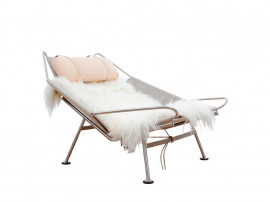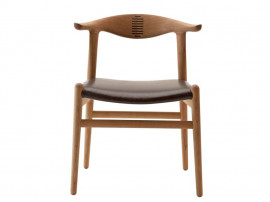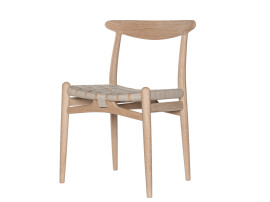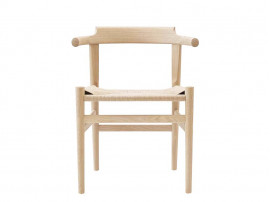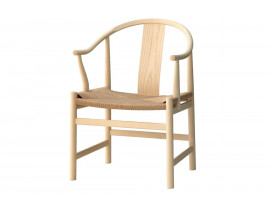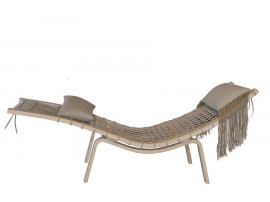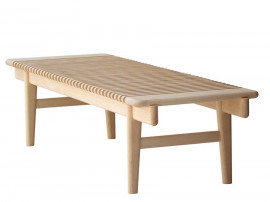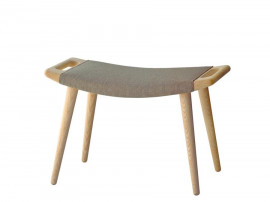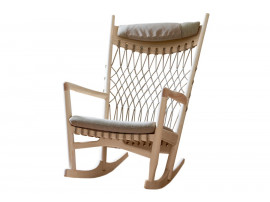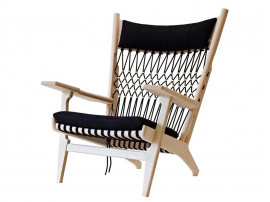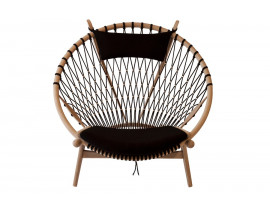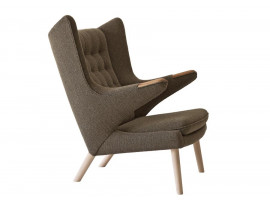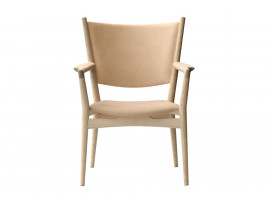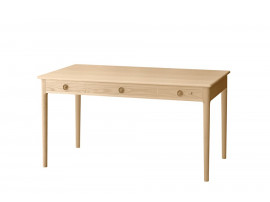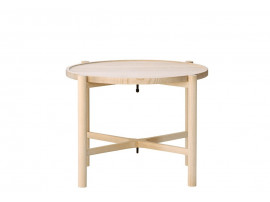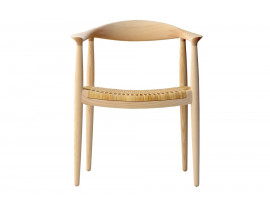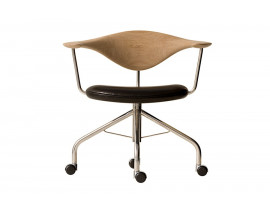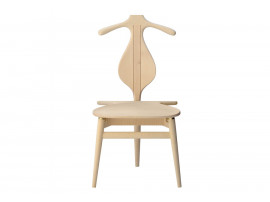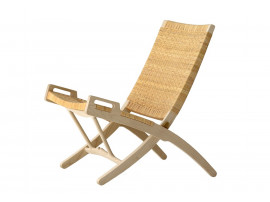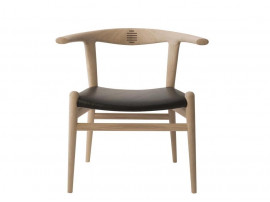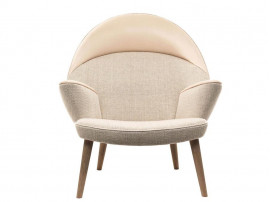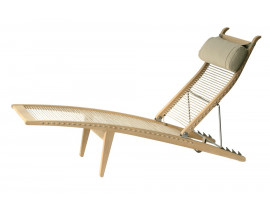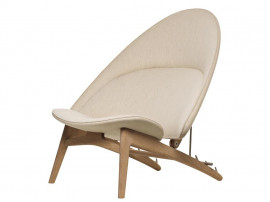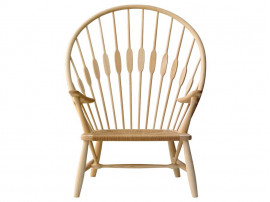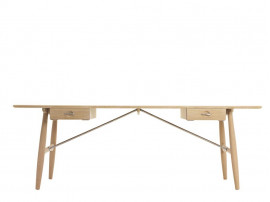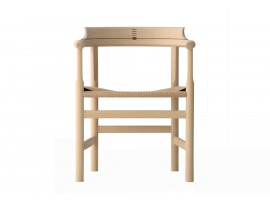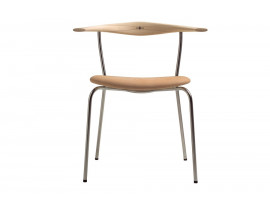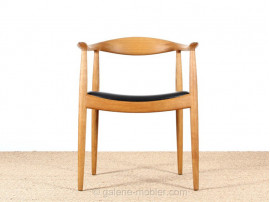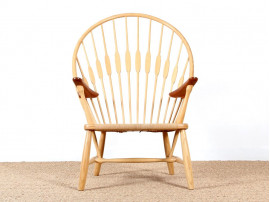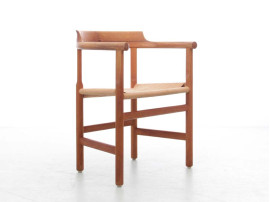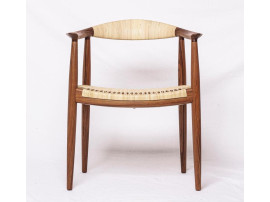
PP Møbler
The story of PP Møbler starts in the small town of Vejen in Jutland where the two brothers, Ejnar and Lars Peder Pedersen, complete their cabinet maker training with Master of Crafts, Søren Villadsen.
Shortly after, in 1948, Ejnar and Søren Villadsen’s son Knud set up a workshop in Rungsted and later in Allerød. However, the partnership ends in 1953. During this brief period Ejnar becomes acquainted with, among others, Jørgen and Nanna Ditzel, and Gunnar Aagaard Andersen.
During its short lifespan, the workshop was involved in series of interesting experimental projects with different artists and designers. This allowed Ejnar to establish a solid network. When the workshop closed in 1953, it was only natural for Ejnar to go to his brother and suggest that they start a workshop of their own.
On Maundy Thursday, the 2nd of April 1953, Ejnar Pedersen began building a 150 m2 workshop. The company is still at the same address, but today the workshop has grown to 1800 m2.
Setting up a workshop is hard work, as Ejnar and Lars Peder discovered. In the daytime they worked on building the workshop and, at night, they built furniture in a borrowed workshop. At the beginning, it was especially Ejnar’s own designs which were being produced. But before long, orders started coming in for designed products. The first customers were Bovirke (who sell furniture by among others Finn Juhl), the furniture shop William Watting, and A.P. Stolen, for whom PP Møbler produced the lower frame for Hans J. Wegner’s no 19, The Teddy Bear Chair.
As early as 1955, PP Møbler embraced the more experimental sides to cabinet making - and not least the possibilities of wood, which has been characteristic of the workshop ever since. Together with artist Gunnar Aagaard some highly interesting prototypes were developed. This marked the beginning of extensive developmental work with designers and artists, which has left some outstanding marks in Danish design history.
In 1956, PP Møbler extended for the first time (out of seven) by adding a 150 m2 machine workshop. The following year the first journeyman, Ove Metysia, completed his apprenticeship at the workshop, receiving a silver medal for his final project.
By the end of the 1950's, PP Møbler had established itself in Denmark as a serious and innovative workshop. In the 1960's it started to work with Danish architect, Hans J. Wegner. Together they developed the prototype for the Ox-chair, which today is manufactured by Erik Jørgensen’s Møbelfabrik A/S.Over the following years, from 1962 to 1968, they continued to work together, creating many exciting prototypes, which were produced at other workshops and factories, mainly at Getama and AP Stolen.
After years of successful cooperation throughout the 1960's, Wegner drew his first chair for PP Møbler, PP 203, which launched in May 1969. An important factor in Wegner’s reputation is PP Møbler’s uncompromising attitude to quality and materials. One anecdote recounts that Wegner was not too concerned about the perfection of the lower frame for The Teddy Bear Chair, since it was to be covered by upholstery. Ejnar responded by stating that the journeymen also needed to be proud of their craft. work, the company would not allow second-rate craftsmanship to be sold.
The well-known Danish architectural critic, Henrik Steen Møller said the following about PP Møbler’s attitude to their craft, which Wegner discovered in the 1960's: 'The workshop in Allerød has several trademarks: Quality in the true sense of the word, meaning from idea through material to execution and result...' (exxperiments p. 9)
Working with Wegner took PP Møbler through a new, constructive expansion period at the beginning of the 70’s. The company expanded the joining workshop by 400 m2 in 1972. This was the fourth expansion – the second took place in 1961, adding 400 m2 to the machine workshop, and the third in 1965, integrating all buildings and bringing the company together under one roof. 1972 was a busy year. The workshop took over several Wegner models from Andreas Tuck, and the company’s production grew to the extent that a first full-time salesman, Gerhard Olsen, was hired.
In the meantime, the second generation of the family-run company, Søren Holst Pedersen, completed his apprenticeship as a cabinet maker with Virum Møbelsnedkeri in 1969. However, he continued training and graduated as a wood technician from Dansk Teknologisk Institut. Nevertheless, he did not come back to PP Møbler immediately, but chose to work in Silkeborg for five years with Dansk Spånplade Kompagnis Laboratorium. In 1977 he returned and started work as production manager at PP Møbler.
In 1974, PP Møbler started exporting furniture to the Japanese market, working with a Japanese chain of furniture shops where Hans Kristensen, who later became PP Møbler’s regular salesman on the Japanese market, was manager. Today, Japan is still one of PP Møbler biggest export markets. This can be explained by the country’s long tradition in arts and crafts alongside an attention to quality, just like at PP Møbler.
In the latter half of the 1970's, PP Møbler underlined position as one of the most important actors on the Danish furniture scene for design and quality. Several new Wegner models were created and the first major interior decoration projects started appearing. Thus, PP Møbler, working with Poul Kjærholm, started producing concert hall chairs for the Museum of Modern Art, Lousiana. The work was demanding, challenging visual expression and encompassing innovative work on wood as an acoustic material. The concert hall, which still has the original chairs, bears witness to PP Møbler’s ability to manufacture furniture with a life-span as long as the material itself. The same year, PP Møbler worked with interior decorator Niels Fagerholt on an exhibition, Mesters Møbler, at Statens Kunstfond.
The following years saw important organisational re-structuring at PP Møbler. In 1977, Lars Peder left company management in order to concentrate on his craft, leaving Ejnar as sole manager until the generational change in 1998. During this period the workshop was awarded the Møbelfabrikantforeningens Furniture Award in 1980, the Bruno Mathsson Award in 1996, and Nationalbankens Honorific Award in 1998.
Wegner continued to design new models for PP Møbler throughout the 1980's, with the culmination of design and craftsmanship in The Circle Chair, which transgress the technological and formal limits of the craft. But the decade also saw many projects to create interiors for various institutions. A large quantity of Wegner chairs were delivered to DSB ferries in 1981, in Holstebro Town Hall, minimalist and organic interiors were created in cooperation with Dahl and Lindhardsen in 1986, and in 1988 Baltica’s headquarters in Ballerup were furnished with Wegner’s PP 58.
As the craftman-like and technological demands for The Circle Chair indicate, PP Møbler was even more focused on innovation. This was partly due to Søren being back at the workshop after having worked as production manager at Fritz Hansens Møbelfabrik from 1982-87.
At the beginning of the 1980's, Søren worked with Dansk Teknologisk Institut on a new technique called precompression, which was successfully implemented when PP Møbler started manufacturing Poul Kjærholms chair PK 15. The return of Søren also signalled the beginning of a generational change at PP Møbler.
Many new models were created for PP Møbler in the 1990's. There was still plenty from Wegner, but other internationally recognised designers were contributing. The prototype for Nanna Ditzels popular Trinidad Chair was developed, Verner Pantons curious VIPP went into production, and the company started working with Professor Vilhelm Wohlert. The decade also saw many large-scale interior projects, both nationally and internationally. Churchill College in England was furnished with Wegner chairs, as was the Sagawa Museum in Japan, and several ministries in Folketinget.
The 1990's was also the decade which saw Hans J. Wegner celebrated at a special exhibition at Dansk Arkitektur Centerin 1991 which, in the following years, became a global event. The exhibition visited Okinawa in Japan, Toronto in Canada, Switzerland and Tønder, Wegner’s home town. PP Møbler was also involved on a more specific note at Munkeruphus working with architect Ole Gjerløv Knudsen.
By the end of the decade, PP Møbler started working with Søren Ulrik Petersen, who so far has supplied several new pieces of furniture for the collection. In 2003, at the occasion of PP Møbler 50th anniversary, Dansk Design Center presented the exhibition ‘Ekspperiments’ focusing on PP Møbler’s experimental prototypes. Curator for the exhibition was the architect Professor MMA Hanne Kjærholm.

